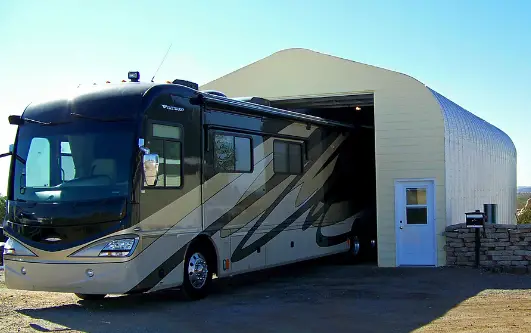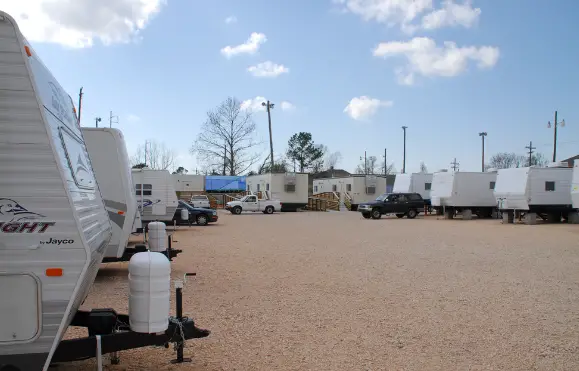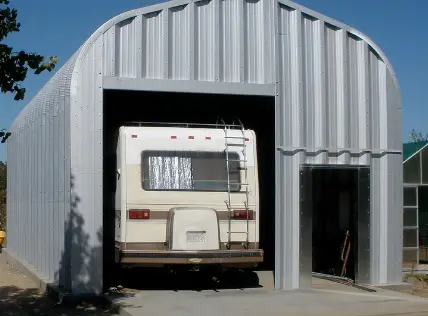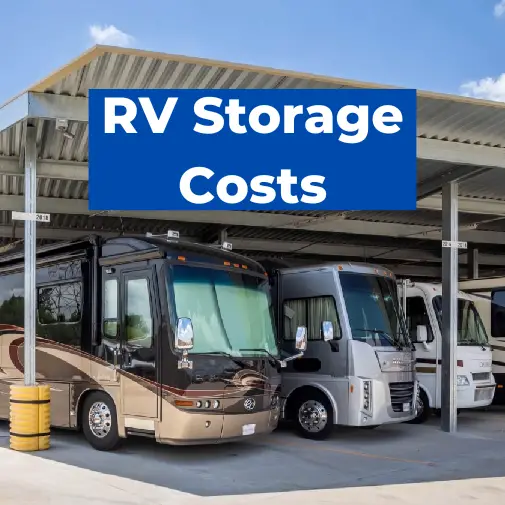Recreational vehicles (RVs) provide a level of comfort and convenience for those who enjoy exploring the great outdoors. However, when it comes to the offseason or simply finding a place to store the vehicle when not in use, RV owners must consider the costs of storage. With various options available, including indoor and outdoor facilities, as well as covered and uncovered spaces, understanding the range of costs can assist owners in making the best decision for their needs.
Typical RV storage costs can vary depending on the size of the RV and the specific type of storage selected. On average, the cost of storing an RV indoors ranges from $50 to $450 per month, while outdoor storage options can range from $30 to $100. Factors that influence the final price include location, accessibility, amenities, and level of protection for the vehicle against the elements.
When selecting an RV storage facility, it is essential to consider what features are necessary for you.
We’ll go over everything you need to know when figuring out how much to pay for RV storage in this guide.
How Much Does RV Storage Cost?

Average Cost by RV Storage Type
When it comes to RV storage, the cost can vary depending on the type of storage you choose. Here are a few typical pricing options based on storage type:
- Outdoor RV Storage: This is the most basic storage option and can cost anywhere from $30 to $100 a month. It usually involves parking the RV in an open lot without any covering or protection from the elements.
- Covered RV Storage: This option provides a roof or covering, offering some protection from the sun and rain. Prices range from $50 to $125 a month.
- Indoor RV Storage: You have non-climate-controlled and climate-controlled indoor storage options which provide the best protection for your RV. The cost for this type of storage can range from $100 to $450 a month, with heated storage being at the higher end of this range.
RV Storage Cost by Size
The size of your RV also impacts the cost of storing it. Here is a general guide for storage prices based on vehicle size:
- Class A Motorhome: These large motorhomes typically require more significant storage spaces, ranging from $100 to $450 a month.
- Class B Motorhome: Storage costs for these medium-sized motorhomes can range from $100 to $250 a month.
- Class C Motorhome: These smaller motorhomes may cost around $50 to $150 a month to store.
- Travel Trailers: Depending on the size, the storage cost can vary between $30 and $100 a month.
- Pop-up Trailers: These compact trailers generally cost around $30 to $50 per month for storing them.
Your Location Makes A Difference
Location plays a crucial role in determining RV storage pricing. More populated areas or those located near popular travel destinations may have higher storage fees due to demand and limited space.
For example, storing an RV in Phoenix, AZ, may cost more than storing it in a rural area with less traffic and fewer RV owners.
Common RV Storage Amenities
Some storage facilities offer additional amenities and services that can impact the cost of RV storage. These may include:
- Security: Enhanced security measures such as gated access, video surveillance, and on-site staff can result in higher storage costs.
- Climate Control: If your RV requires protection from extreme temperatures, climate-controlled storage units may be necessary, increasing the cost.
- Dump Stations: Some facilities offer dump stations for added convenience, possibly raising the price.
- Parking Spaces: Paved parking lots or well-maintained, level spaces can also come with a slightly higher cost.
The cost of storing an RV depends on a variety of factors, including the type of storage, the size of the vehicle, the location of the storage facility, and the available amenities.
Researching and comparing different storage options in your area can help you find a storage solution that meets your needs while staying within your budget.
Average RV Storage Costs by State

RV storage costs can vary greatly depending on the location, type of storage, and services provided. This section presents data collected from all 50 states, focusing on average indoor RV storage prices:
Alabama: 10 feet by 20 feet; $99 monthly (Indoor unheated Unit)
Alaska: 10 feet by 30 feet; $600 for eight months-seasonal (Indoor heated unit)
Arkansas: 10 feet by 40 feet; $114 monthly (Outdoor unit)
Arizona: 10 feet by 30 feet; seasonal-winter only; $700 for six months (Outdoor unit)
California: 10 feet by 30 feet; $140 monthly (Outdoor unit)
Colorado: 10 feet by 20 feet; $230 monthly (INdoor heated unit)
Connecticut: 10 feet by 40 feet; $85 monthly (Indoor heated unit)
Delaware: 10 feet by 30 feet; $155 months (Indoor unit)
Florida: 10 feet by 30 feet; $99 monthly, six months minimum winter season (Outdoor unit)
Georgia: 10 feet by 30 feet; $90 monthly (Outdoor unit)
Hawaii: 10 feet by 30 feet; $225 monthly (Outdoor unit)
Idaho: 10 feet by 40 feet; $53 monthly (Indoor heated unit)
Illinois: 10 feet by 30 feet; $85 monthly (Indoor unit)
Indiana: 10 fee by 35 feet; $150 monthly (Indoor unheated unit)
Iowa: 10 feet by 30 feet; $50 monthly (Outdoor unit)
Kansas: 10 feet by 30 feet; $55 monthly (Outdoor unit)
Kentucky: 15 feet and over; $125 monthly (Underground storage)
Louisiana: 10 feet by 25 feet; $40 monthly (Unspecified)
Maine: 10 feet by 25 feet; $45 monthly (Outdoor unit)
Maryland: 12 feet by 25 feet; $139.00 monthly (Outdoor unit)
Massachusetts: 10 feet by 20 feet; $140 monthly (Indoor heated unit)
Michigan: 10 feet by 20 feet; $12 per foot per season (Indoor heated unit)
Minnesota: 10 feet by 20 feet; $125 monthly (Indoor heated unit)
Mississippi: 10 feet by 30 feet; $140 monthly (Outdoor unit)
Missouri: 10 feet by 35 feet; $75 to $125 monthly (Outdoor unit)
Montana: 26 feet by 30 feet; $120.00 monthly or a seven month season (Indoor unit)
Nebraska: 10 feet by 20 feet; $125 monthly (Indoor heated unit)
New Jersey: 10 feet by 20 feet; $40 monthly (Outdoor unit)
New Hampshire: 14 feet by 46 feet by 18 feet for extra large RVs; $175 monthly (Climate controlled unit)
New York: 10 feet by 30 feet; $229 monthly (Indoor heated unit)
Nevada: 15 feet by 45 feet; $100 to $500 monthly (Indoor unit)
New Mexico: 10 feet by 25 feet; $250 monthly (Outdoor unit)
North Carolina: 10 feet X 25 feet; $55 monthly (Outdoor covered parking unit)
Ohio: 16 feet by 45 feet; $370 for a 3-month lease (Climate controlled and monitored unit)
Oklahoma: 10 feet by 30 feet; $150 monthly (Indoor heated unit)
Oregon: 10 feet by 30 feet; $180 monthly (Indoor unit)
Pennsylvania: 15 feet by 25 feet; $243 monthly (Indoor heated unit)
Rhode Island: Up to 40 feet; $250 monthly (Indoor heated unit)
South Carolina: Up to 50 feet; $80 monthly (Outdoor unit)
South Dakota: Up to 40 feet; $225 monthly (Indoor heated unit)
Tennessee: 26 feet by 30 feet; $120.00 monthly or 4-month lease (Indoor heated unit)
Texas: 10 feet by 30 feet; $50 to $70 monthly (Outdoor unit)
Utah: 15 feet by 35 feet; $230 monthly (Outdoor covered unit)
Washington: Starts at $40 monthly for the first 20 feet. (Outdoor unit) , Starts $125 monthly for the first 16 feet (Indoor unit)
Vermont: 10 feet by 30 feet; $100 monthly (Indoor unit)
Virginia: 10 feet by 50 feet; $220 per quarter (Outdoor covered unit)
West Virginia: 10 feet by 30 feet; $150 monthly (Indoor climate-controlled unit)
Wisconsin: Up to 30 feet; $225 monthly (Indoor heated unit)
Wyoming: 10 feet by 30 feet; up to $250 monthly (Indoor heated unit)
The nationwide average cost for indoor RV storage is about $134.35 per month according to SpareFoot data. This figure represents a 3.3% increase in RV rental storage rates compared to the previous year, signaling that demand for RV storage is on the rise.
For those wanting to store their RV in a more secure and protected environment, indoor RV storage typically starts between $50 and $125 per month but can extend up to $450 monthly, based on the size of the RV and the amenities provided. Enclosed RV storage is considered the premier option as it offers the best protection. Heated RV storage, which is particularly useful for wintering the vehicle, can cost anywhere from $100 to $450 per month.
What Is the Best Way to Store an RV?

When considering RV storage, multiple factors play a role in determining the ideal solution for your motorhome. These factors include location, size, type, cost, and security. By understanding the various types of RV storage, you can choose the best option to suit your needs, budget, and RV type.
Types of RV Storage
RV storage facilities offer a range of options, such as indoor storage, outdoor storage, and covered storage. Each type comes with its own advantages and costs, which vary depending on location, availability, and amenities.
Indoor RV Storage: Indoor storage units are typically the most secure and expensive option. They offer climate control, protection from the elements, and added security. The average cost of indoor RV storage is around $130 per month, but prices can range between $50 and $450 depending on location and RV size. This type of storage is suitable for Class A, Class B, and Class C motorhomes, as well as travel trailers and pop-up trailers.
Outdoor RV Storage: Outdoor storage spaces are a more affordable option compared to indoor storage, with costs ranging from $30 to $100 per month. These spaces may be simple parking spots in an open lot or paved parking areas, often located on a self-storage facility’s property. While outdoor storage offers limited protection from the elements and potential vandalism, it is generally more accessible and convenient. This type of storage is appropriate for various RV types, including Class A, Class B, and Class C motorhomes, and travel trailers.
Covered RV Storage: Covered storage offers added protection compared to outdoor storage without the higher cost of indoor storage. These storage spaces can be open-sided or enclosed and may provide some level of climate control. Prices for covered RV storage vary depending on location and amenities, but generally fall between the costs of outdoor and indoor storage. Covered storage is suitable for all types of RVs, including Class A, B, and C motorhomes, as well as travel trailers.
Choosing the Best RV Storage Option
To find the best RV storage option, consider the following factors:
- RV Size and Type: Class A motorhomes, Class B motorhomes, and Class C motorhomes have different storage requirements due to their varying sizes. Smaller RVs, such as pop-up trailers and travel trailers, can fit in different types of storage spaces.
- Location and Accessibility: Consider the proximity of the storage facility to your home and how often you will access your RV. Additionally, ensure the facility has convenient operating hours to accommodate your schedule.
- Security: Evaluate the security features of the storage facility, including surveillance cameras, gated access, and on-site management.
- Cost: Determine your budget for RV storage and compare the costs of different storage types in your preferred location. Online resources, such as SpareFoot, can help you find and compare RV storage facilities.
- Amenities and Services: Some facilities offer additional services, such as dump stations, winter storage preparation, and limited maintenance. Consider the value these amenities provide when choosing your RV storage solution.
By considering these factors, you can select the best storage option for your RV, ensuring its safety, preservation, and accessibility.
Alternatives To Paying For RV Storage

Store It At Your Home
One cost-effective alternative to paying for RV storage is to store the RV at home. If the owner has sufficient space, such as a driveway or a yard, they can park the RV there when not in use.
This option offers convenience and immediate access to the RV at no additional cost. It’s essential to ensure compliance with local zoning laws and homeowner association rules, as some neighborhoods have restrictions on RV parking.
Some tips for successfully storing an RV at home include:
- Make sure the RV is parked on a flat, level surface to prevent any damage to the tires or suspension system.
- Use wheel chocks to prevent accidental rolling or movement.
- Protect the exterior of the RV with a suitable cover, especially in harsh weather conditions, to help prolong its life and maintain its appearance.
Rent Out Your RV
For RV owners who don’t use their RVs consistently, another alternative to paying for storage is to rent out the RV through a peer-to-peer rental platform. This option not only eliminates storage fees but can also generate income. Websites like Outdoorsy, RVezy, and RVshare connect RV owners with potential renters, allowing for a seamless rental process.
Some benefits of renting out an RV include:
- Generating income that can offset ownership costs, such as insurance and maintenance.
- Taking advantage of tax deductions related to the rental business, which can further offset ownership expenses.
You should consider the potential wear and tear on the RV from renters and be prepared for the additional time and effort required to manage the rental process, such as cleaning, maintaining, and listing the RV.

